
94% of researchers rate our articles as excellent or good
Learn more about the work of our research integrity team to safeguard the quality of each article we publish.
Find out more
ORIGINAL RESEARCH article
Front. Conserv. Sci., 01 November 2023
Sec. Human-Wildlife Interactions
Volume 4 - 2023 | https://doi.org/10.3389/fcosc.2023.1271223
 Evan Gerald Prasky1
Evan Gerald Prasky1 J. Marcus Drymon2,3*
J. Marcus Drymon2,3* Mandy Karnauskas4
Mandy Karnauskas4 Alena Q. Anderson2
Alena Q. Anderson2 Sarah L. Gibbs5,6
Sarah L. Gibbs5,6 Jonathan H. Grabowski1
Jonathan H. Grabowski1 Amanda E. Jargowsky2,3
Amanda E. Jargowsky2,3 Danielle M. McAree2
Danielle M. McAree2 Ana R. Osowski2,3
Ana R. Osowski2,3 Savannah H. Swinea1,5,6
Savannah H. Swinea1,5,6 Steven B. Scyphers5,6,7
Steven B. Scyphers5,6,7Overfishing, habitat degradation, and climate change have caused declines in shark populations throughout the world’s oceans. However, in the United States Gulf of Mexico (GoM), populations of several coastal shark species are starting to stabilize following decades of successful regulations and enforcement. The stabilization of coastal shark populations, coupled with increases in recreational fishing effort, has the potential to escalate human-wildlife interactions. The most often reported conflict is shark depredation, the partial or complete removal of a hooked species by a shark. Reported increases in shark depredation within the last several years have begun to erode angler support for shark conservation, potentially undermining decades of previous work. To address these concerns, we implemented a GoM-wide online survey to characterize the impact of depredation on recreational reef fish anglers’ fishing satisfaction and perceptions of shark management and conservation. Our results revealed that most recreational anglers in the GoM have witnessed depredation but have not changed their fishing behaviors. In contrast, anglers’ viewpoints on managing shark populations were split between reducing population sizes and maintaining current population levels. As coastal shark populations in the GoM continue to recover, shark depredation is likely to increase. Consequently, efforts to characterize anglers’ satisfaction and perceptions are a critical component of future shark conservation initiatives.
Over the past century, overfishing, habitat degradation, and climate change have contributed to the decline of shark populations throughout the world (Worm et al., 2013; Dulvy et al., 2021). Globally, pelagic shark species have faced steep population declines, upwards of 71% since the 1970s, and coastal sharks have faced even more significant declines ranging between 74-92% since the 1960s (Roff et al., 2018; Pacoureau et al., 2021). These rapid declines are primarily due to increased fishing pressure, causing many species to experience overfishing and their stocks to be classified as overfished (Pacoureau et al., 2021). Several factors may contribute to sharks’ susceptibility to overfishing, particularly their life history characteristics, which may include relatively slow growth, late onset sexual maturity, long life span, relatively low fecundity, etc. (Kindsvater et al., 2016). In the Northwest Atlantic Ocean, population declines occurred for some shark species as commercial fishermen were encouraged to target what was considered an underused resource at the time (Musick et al., 1993).
Recovery efforts began in the eastern United States following the implementation of an Atlantic shark fishery management plan (FMP) in 1993 (National Marine Fisheries Service, 1993; Carlson et al., 2012). The objective of the 1993 FMP was to ensure the long-term viability of shark stocks in the Atlantic and Gulf of Mexico (GoM) by establishing calendar year quotas, reducing recreational harvest, and prohibiting finning (National Marine Fisheries Service, 1993). Nonetheless, a 1998 coastal shark stock assessment revealed that overfishing was still occurring, and quotas had to be reduced again, particularly for sandbar shark (Carcharhinus plumbeus) and blacktip shark (C. limbatus, National Marine Fisheries Service, 1999). This process continued, and by 2008, four more FMPs were introduced to reduce the total allowable catches for commercial and recreational anglers (Carlson et al., 2012). Consequently, following decades of successful regulations and enforcement, some coastal shark populations show signs of recovery (Peterson et al., 2017; Pacoureau et al., 2023).
This commitment to the long-term viability of shark stocks may adversely affect anglers’ fishing satisfaction. Human-shark conflicts are multidimensional and complex (Simpfendorfer et al., 2021). Notable among these conflicts is shark depredation, the partial or complete removal of a hooked species by a shark (Gilman et al., 2007; Mitchell et al., 2023). In the GoM, anglers have reported rapid and significant increases in shark depredation during the past 5 years (Drymon et al., 2022), and often attribute the interaction to confirmed depredators like sandbar shark and blacktip shark (Drymon et al., 2019). Increasing shark depredation has the potential to negatively impact recreational anglers’ perceptions of, and willingness to support, shark conservation (Robinson et al., 2022). Thus, a broader understanding of the degree to which recreational anglers are experiencing depredation will help inform future management and conservation efforts for sharks.
The recently reported increases in depredation may be the result of several factors, including changes in fishing practices, learned behavior of sharks, reductions in natural prey, and environmental shifts; however, many anglers believe depredation is increasing because of increasing shark populations (Mitchell et al., 2023). Therefore, the goal of this work was to characterize the frequency and impact of coastal shark depredation in the United States GoM based on recreational anglers’ perceptions and knowledge of shark management and conservation. Specifically, our objectives included (1) quantifying shark depredation rates, (2) understanding anglers’ experience with shark depredation, (3) gauging anglers’ support for, or opposition to, shark management and conservation, and (4) documenting anglers’ perceptions on preliminary population recovery of selected shark species in the region.
An online survey was developed to understand how shark depredation impacts reef fish anglers’ fishing satisfaction. The survey was designed and implemented in Qualtrics XM, an online platform for building and conducting surveys. The survey data described in this paper represent questions across the following five categories: 1) Angler characteristics; 2) Depredation characteristics and frequency; 3) Impact of shark depredation on anglers; 4) Factors influencing shark depredation; and 5) Shark population management (Table 1). Multiple branching questions were used to identify and ask specific questions on the primary type of depredation that respondents have encountered (i.e., shark, dolphin, other fish, fill-in-the-blank). If anglers selected that they had experienced a depredation encounter, they were prompted to answer additional questions. A list of known or potential factors that may influence shark depredation was developed in collaboration with other fisheries scientists and anglers. This list was used to identify 12 common factors that may predict higher occurrences of shark depredation. These factors were used to better understand the potential influence of fishing behavior on shark depredation frequency.
Qualtrics Research Panels was contracted to recruit survey participants. Qualtrics Research Panels is a “panel aggregator” that has gained popularity over the last decade as a rigorous and cost-effective approach to online surveys (Harlan et al., 2019; Boas et al., 2020; Miller et al., 2020). To ensure responses were robust, several precautions were taken. First, a self-affirming question required participants to select whether or not they would “provide their best answers”; respondents who indicated “no” were removed from the dataset. Second, two “attention check” questions were included in the survey to detect “speed-running” (finishing the survey faster than 50% of the mean completion time) or “straight-lining” (repeatedly selecting the same answer) (Zhang and Conrad, 2014; Scyphers et al., 2021). Third, Qualtrics provided a data scrubbing service to identify “bots” and other falsified data entries to further improve data quality. The survey was open for 7 weeks, from January 2022 to March 2022. This survey was approved by Northeastern University’s Institutional Review Board (Approval #13-07-16), and informed consent was acquired from all participants.
Data were exported from Qualtrics and imported into RStudio version 4.1.2 (R Core Team, 2021). To evaluate if depredation impacts anglers differently throughout the GoM, Chi-Squared tests with the Holm-Bonferroni method, or nonparametric Kruskal-Wallis tests, were used to evaluate the relationship between responses and states. Similarly, Chi-Squared tests were used to evaluate the relationship between reported shark depredation rates and angler perceptions of shark populations. For all tests, P ≤ 0.05 was considered significant. When a significant P-value was observed, a post-hoc analysis was conducted. A Chi-Squared post-hoc test was used for a Chi-Squared test, and a Dunn’s test was used for a Kruskal-Wallis test (Beasley and Schumacker, 1995; Dinno, 2017; Ebbert, 2019). All Chi-Squared tests were simulated 2000 times using a Monte Carlo simulation. Questions that contained categorical responses with less than five observations were combined with the closest selectable category to ensure the accuracy of Chi-Squared tests.
All questions were visualized using the HH package (Heiberger, 2022). Colorblind-safe shades were selected using the RColorBrewer package and the viridis package (Neuwirth, 2022; Garnier et al., 2023). Other packages used in data preparation and visualization included the Likert package developed by Bryer & Speerschneider (2016), the dplyr package developed by Wickham et al. (2021), and the table1 package developed by Rich (2021).
A total of 740 people participated in the survey, and survey responses were relatively evenly distributed across the five GoM states (n=151, 152, 141, 141, and 155 in Texas, Louisiana, Mississippi, Alabama, and Florida, respectively). Of those 740 respondents, 711 completed demographic sections (Supplementary Table 1). A total of 319 respondents were female, with an average age of 41 ± 12.7 (SD) years. Another 388 respondents were male, with an average age of 39.9 ± 12 (SD) years. Three respondents who preferred not to identify their gender were an average age of 35.3 ± 12.4 (SD) years. One respondent selected other as their gender and was 42 years of age. The remaining 29 respondents who did not fill out the gender section were an average age of 40 ± 14.8 (SD) years.
Anglers self-classified into three groups based on fishing experience: 39.0% were novices, 30.3% were intermediates, and 30.7% were specialists/veterans (Needham et al., 2009; Scyphers et al., 2021). There was no statistical difference in anglers’ self-classification rates across states in the GoM (Chi-Squared test: P=0.14). Anglers also identified one of the following three areas where they primarily fish: bays and rivers (32%), nearshore (closer than 4.8 km or 3 miles, 33.9%), and offshore (greater than 4.8 km or 3 miles, 34.1%). There was no statistical difference between anglers’ primary fishing areas across states in the GoM (Chi-Squared test: P=0.28). Anglers were also asked to identify their primary reef fish target species. The most common species was red snapper (Lutjanus campechanus, 33.1%), followed by hogfish (Lachnolaimus maximus, 13.1%). Each other reef fish species comprised less than 5% of the total.
Respondents were asked two questions about their depredation experiences using the term “bite-off” as an informal synonym. In response, 78.6% of anglers selected that they had experienced a bite-off, and 81.8% selected that they had seen someone else experience a bite-off. Additionally, respondents were asked if they had ever heard the term “depredation.” In response, 80.9% of anglers were somewhat or very familiar with the term, while 19.1% had never heard the term “depredation.” Next, respondents were asked if depredation has changed the way they fished. This question formally defined depredation as follows: “the scenario of a hooked fish being partially or completely removed by a non-target species is referred to by fisheries scientists as “depredation.” Note: This is different from a predator consuming a fish after release.” Only 20.1% of anglers had changed how they fish in response to depredation, 73.8% of anglers had not changed how they fish, and 6.1% did not know (Figure 1). Respondents were then asked to identify the rate at which they have encountered depredation. The median depredation frequency was 30%, the mean was 32%, and the mode was 10% (Figure 2). Depredation rates did not significantly differ across states in the GoM (Kruskal-Wallis test: P=0.21).
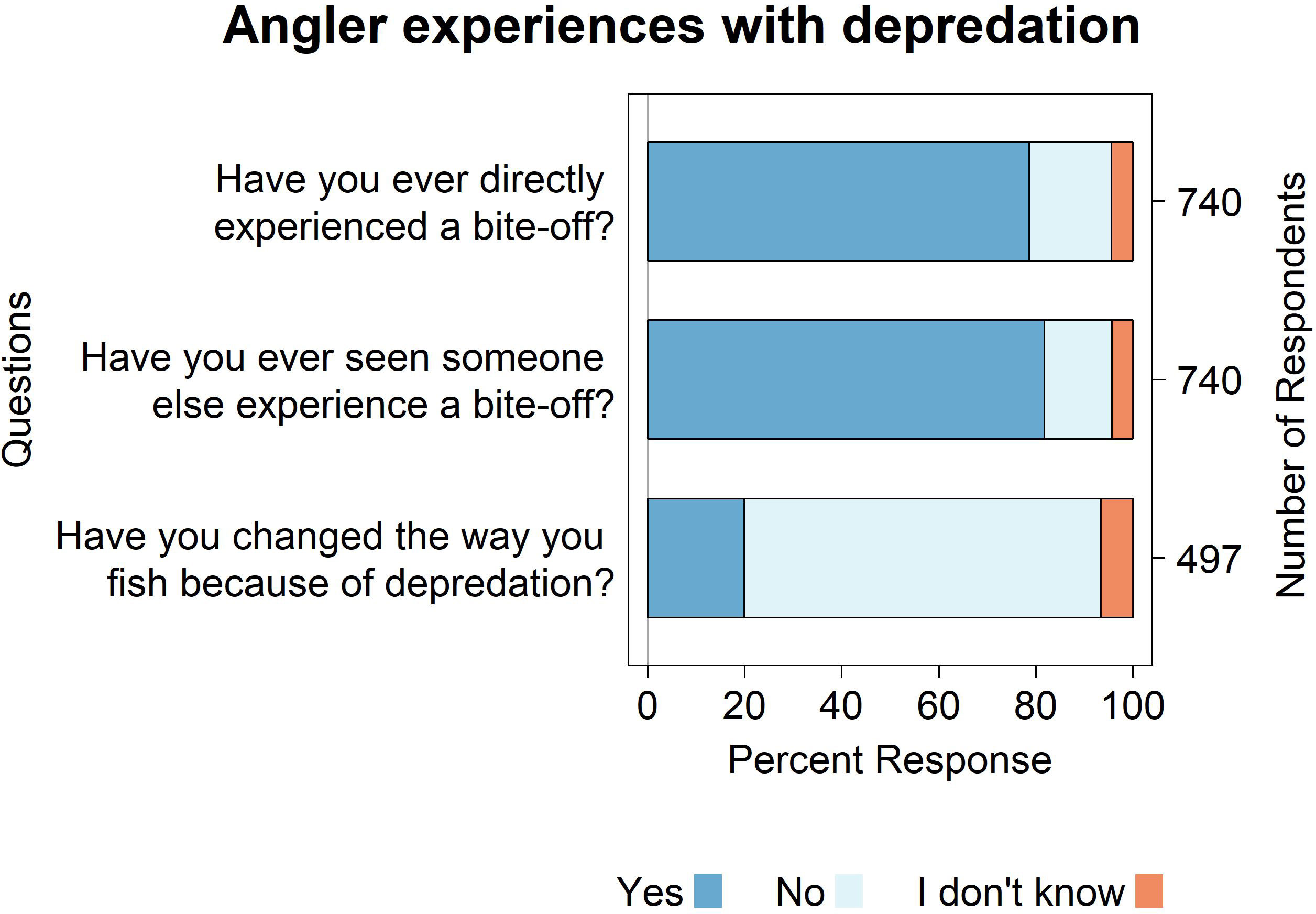
Figure 1 Categorical responses to questions about anglers’ experiences with depredation. The left Y-axis displays the questions asked of the respondents, the X-axis displays the percentage of the total response, and the right Y-axis displays the number of respondents.
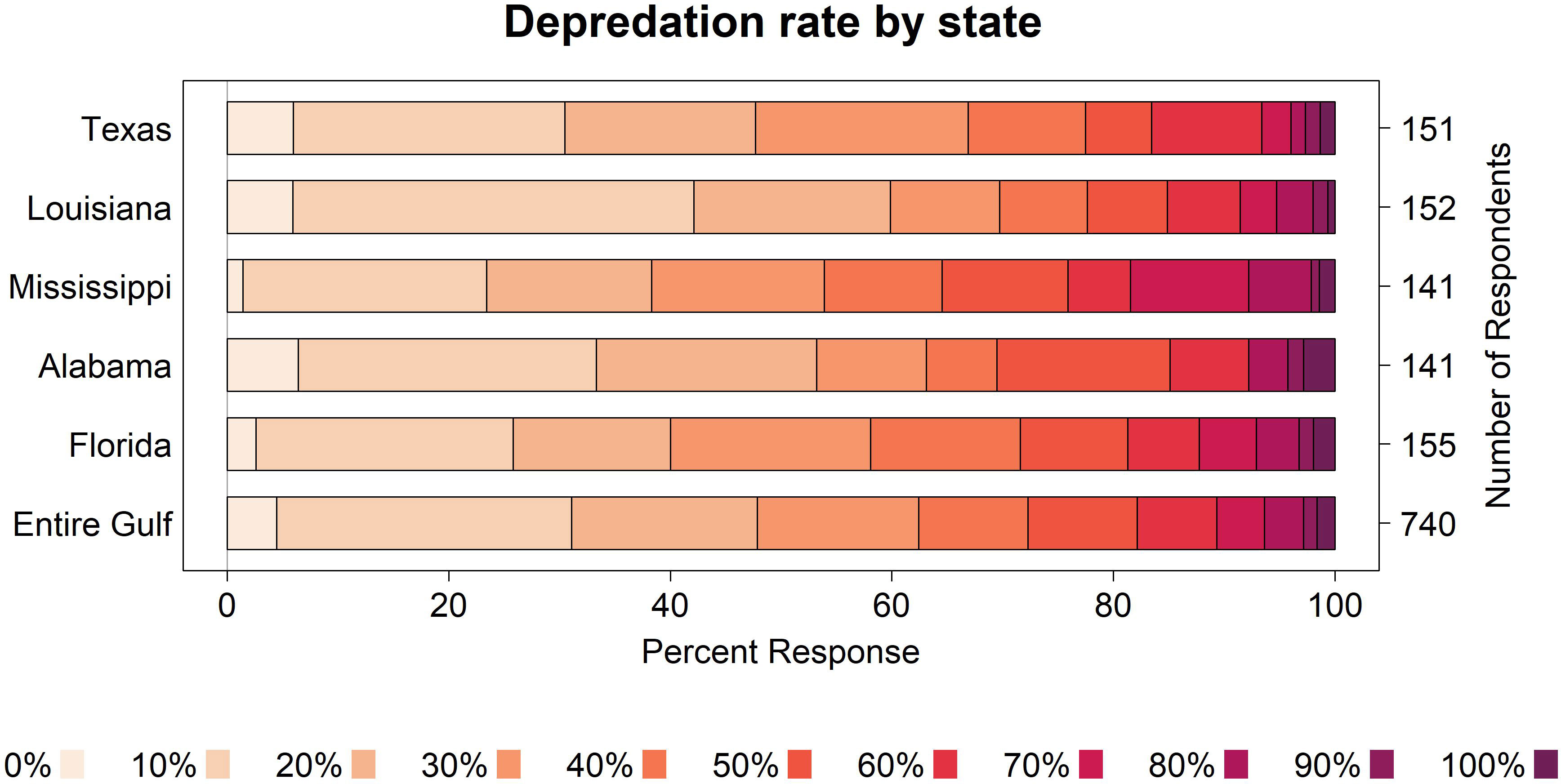
Figure 2 Categorical responses to a question asking about the rate at which anglers have encountered depredation. The left Y-axis displays the individual Gulf of Mexico states and the entire Gulf of Mexico, the X-axis displays the percentage of the total response, and the right Y-axis displays the number of respondents.
To address the perception that shark depredation has been increasing, respondents were asked if shark depredation has impacted their fishing, and if so, when the impacts began. The most often selected response was that it had not impacted anglers’ fishing (45.7%), followed by within the past year (26%) and 5 years ago (18.4%). There was slight variation across the GoM states; in particular, respondents from Louisiana more frequently stated that shark depredation had not impacted their fishing (60%, Chi-Squared post-hoc test: P=0.002). All other responses were similar across the GoM states (Chi-Squared post-hoc test: P=0.37) (Figure 3).
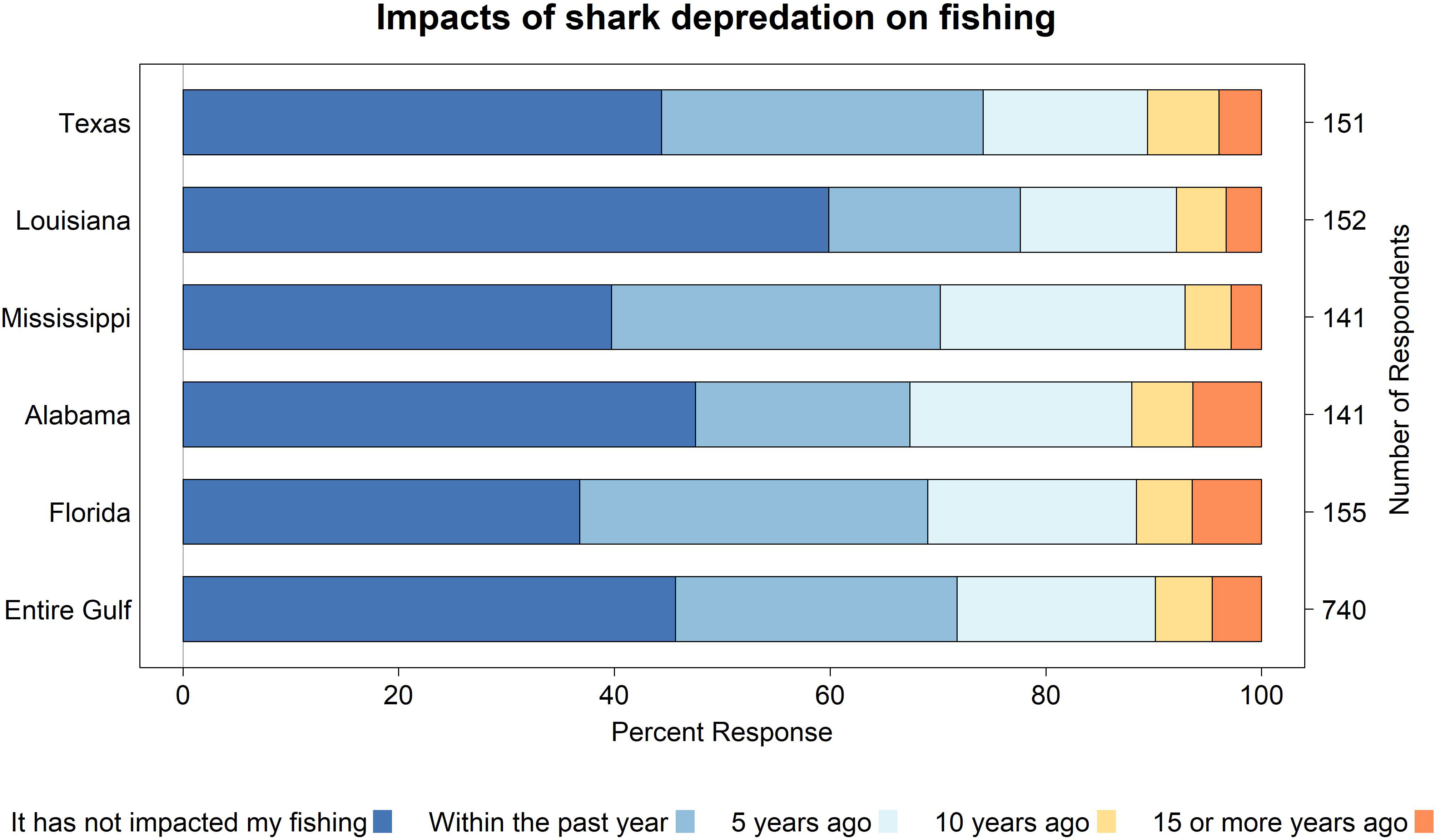
Figure 3 Categorical responses to a question asking if shark depredation has impacted anglers’ fishing, and if so, when the impacts began. The left Y-axis displays the individual Gulf of Mexico states and the entire Gulf of Mexico, the X-axis displays the percentage of the total response, and the right Y-axis displays the number of respondents.
To understand how anglers perceive factors that influence shark depredation, respondents were asked to what extent the following factors influence shark depredation: geographic location, distance from shore, depth, bait type, time of year, target fish species, habitat type, density of fishing vessels near you, number of fishing lines in the water, time spent fishing one area, time of day, and returning to fishing locations. Generally, anglers perceived a wide range of factors to influence shark depredation occurrence; 95% believed that geographic location and habitat type somewhat or strongly influence shark depredation. Similarly, depth and time of year (94% each), as well as target fish species (93%), were believed to somewhat or strongly influence shark depredation. Slightly less influential factors included distance from shore, bait type, density of fishing vessels, time of day, and time spent fishing one area. Alternatively, 11% of anglers believed that the number of fishing lines in the water is not at all influential, while 16% of anglers believed returning to fishing locations is not at all influential (Figure 4).
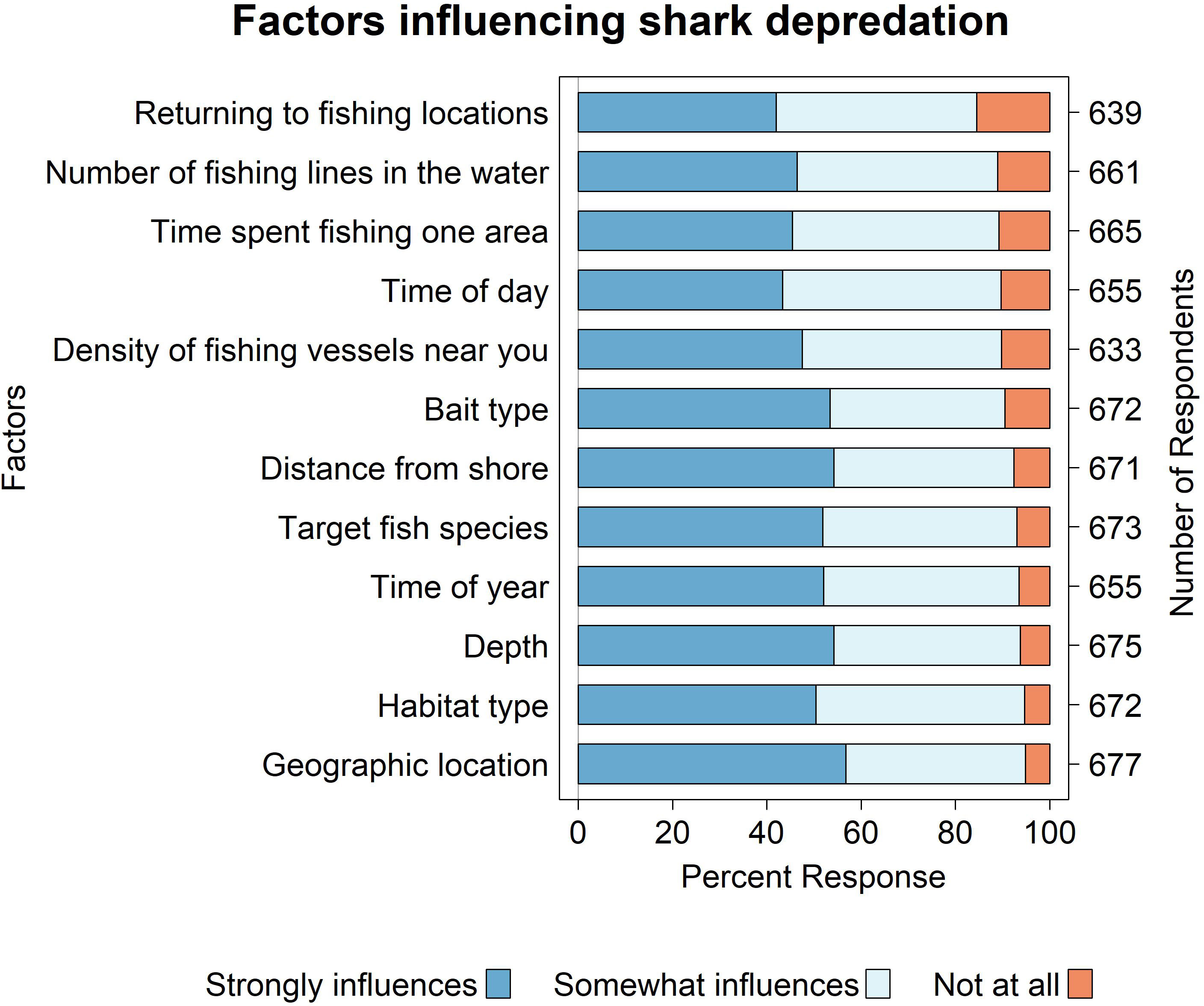
Figure 4 Categorical responses to a question asking anglers the extent to which several factors influence shark depredation. The left Y-axis displays the factors, the X-axis displays the percentage of the total response, and the right Y-axis displays the number of respondents.
To investigate the interaction between shark populations and fisheries management, respondents were asked if shark populations in the GoM should be increased, maintained at current levels, reduced, or eliminated. The most common responses were that shark populations should be maintained at current levels (45.4%) or that shark populations should be reduced (34.9%). Opinions on shark populations did not differ among respondents from different states in the GoM (Chi-Squared test: P=0.70) (Figure 5). To further quantify anglers’ views on shark management, respondents were asked the degree to which they felt shark depredation was a result of regulations to protect sharks. In response, 61.1% of respondents either strongly or slightly agreed with this statement, 28.6% neither agreed nor disagreed, and 10.3% strongly or slightly disagreed. No significant differences were observed across GoM states, except for Mississippi, where respondents selected neither agree nor disagree significantly less than any other state (Chi-Squared test: P=0.008) and Texas where respondents somewhat disagreed significantly more than other states (Chi-Squared test: P=0.04) (Figure 6). Respondents who had never, or only rarely (i.e., 10% depredation rate), experienced shark depredation were more likely to indicate that shark populations should be maintained at current levels (Chi-Squared test: P=0.004 for both comparisons).
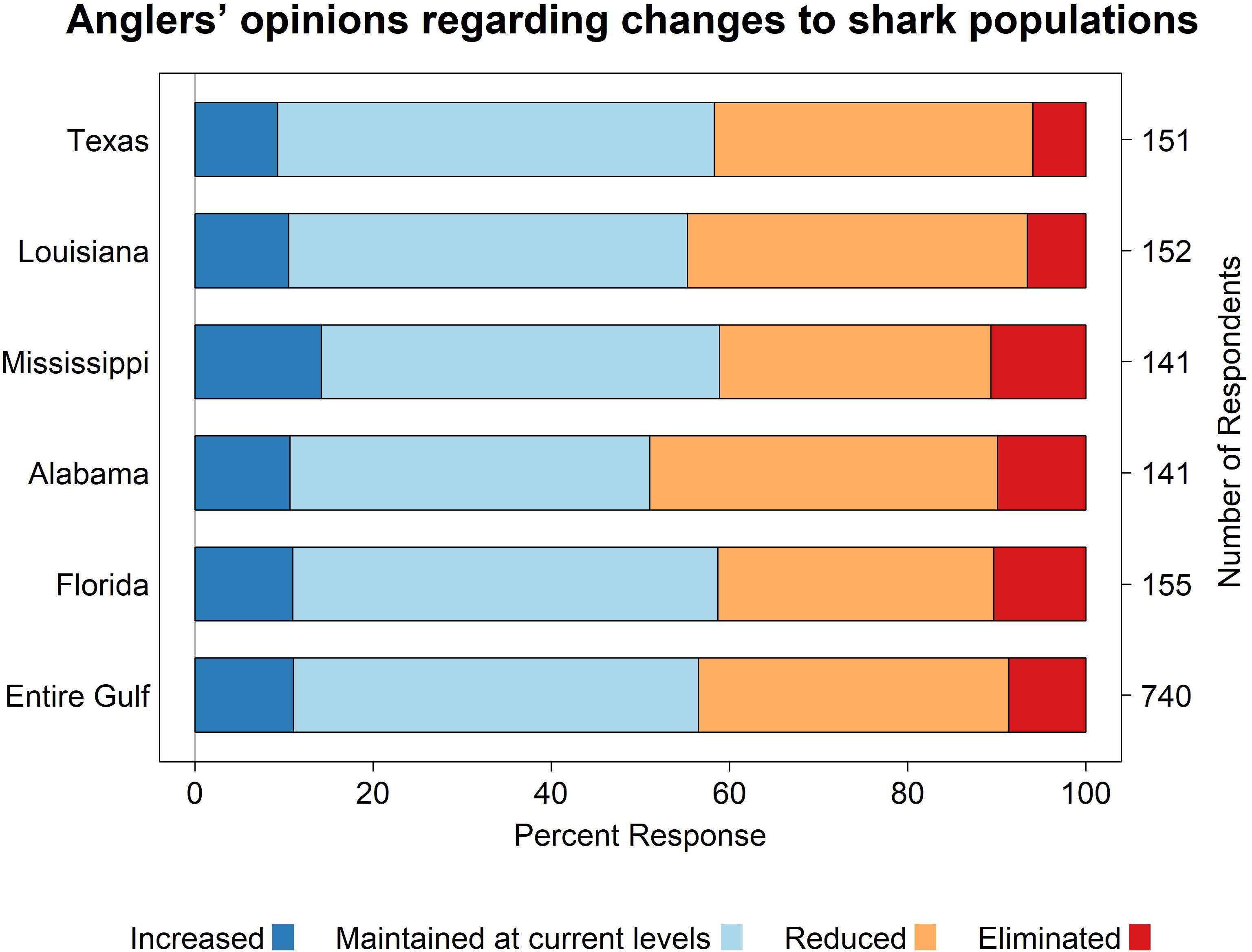
Figure 5 Categorical responses to a question asking anglers if shark populations in the Gulf of Mexico should be increased, maintained at current levels, reduced, or eliminated. The left Y-axis displays the individual Gulf of Mexico states and the entire Gulf of Mexico, the X-axis displays the percentage of the total response, and the right Y-axis displays the number of respondents.
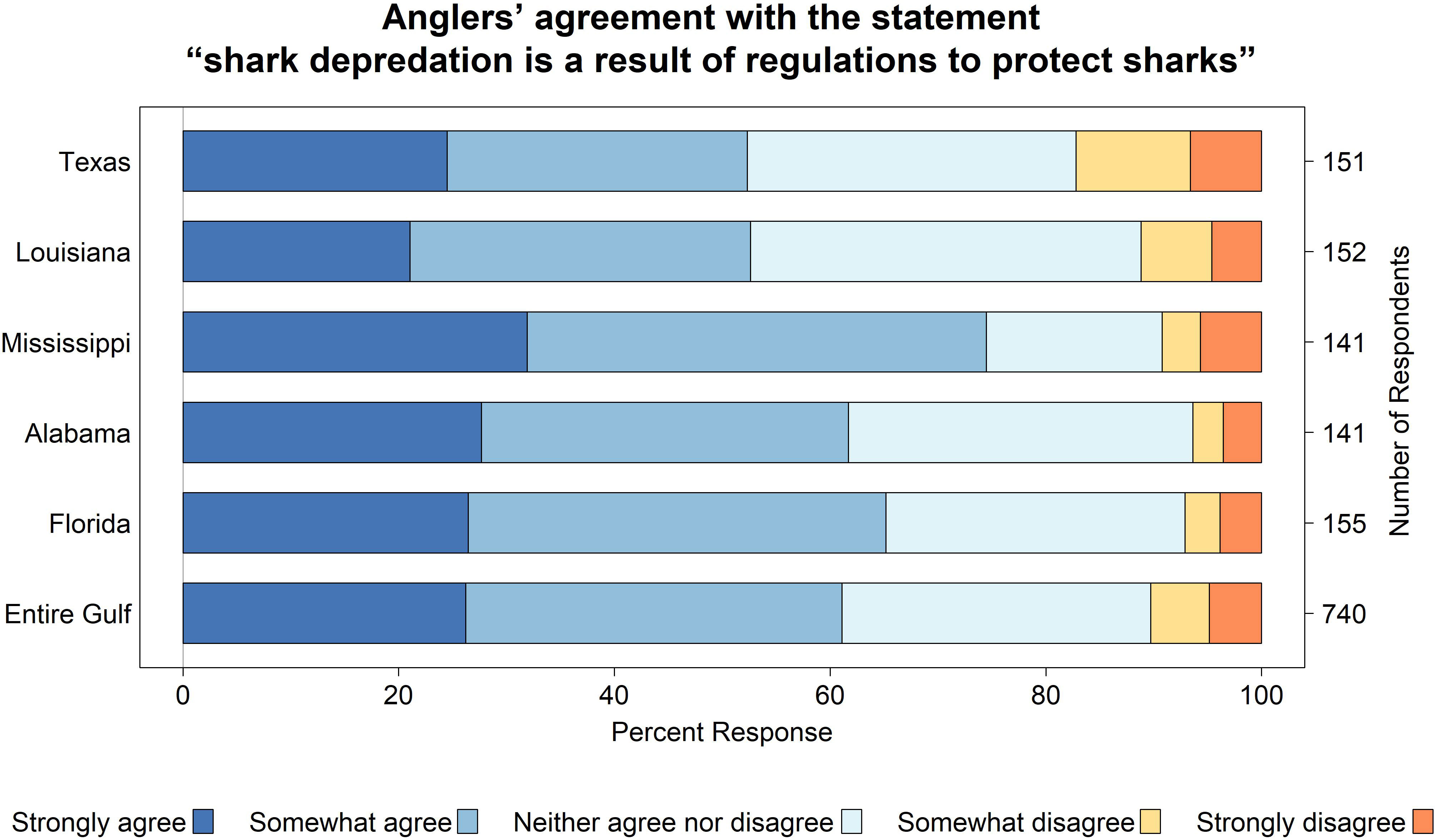
Figure 6 Categorical responses to a question asking anglers the degree to which they feel shark depredation is a result of regulations to protect sharks. The left Y-axis displays the individual Gulf of Mexico states and the entire Gulf of Mexico, the X-axis displays the percentage of the total response, and the right Y-axis displays the number of respondents.
Shark depredation is increasingly reported by stakeholders, particularly in countries with robust shark management initiatives in place (e.g., United States, Australia; Casselberry et al., 2022; Coulson et al., 2022; Mitchell et al., 2023). Most recently, studies have begun to quantify the social complexities of the underlying conflict to better understand how anglers respond to shark depredation (Iwane et al., 2021; Casselberry et al., 2022; Hoel et al., 2022). Our findings further characterize the underlying conflict by attempting to understand how anglers’ perceptions of depredation in the GoM are linked to preferences for fishing regulations and conservation measures for sharks.
Results from our survey highlight that depredation is a relatively common human-wildlife conflict in the GoM; most anglers surveyed have either seen, or personally experienced, depredation. Moreover, the observed depredation rate was consistent across states in the GoM. The similarity we observed was unexpected given the heterogeneous environmental conditions and fishing regulations across the region. However, it is likely that this similarity is a function of the relatively coarse scale of our survey. Previous studies quantifying spatial trends in depredation indicate that it occurs more frequently in areas with higher recreational fishing pressure (Mitchell et al., 2018). Accordingly, future efforts to identify depredation hot spots across the GoM should link recreational fishing effort to fine-scale depredation rate estimates.
Many anglers in the current study perceive that shark depredation has increased in recent years. These findings are consistent with similar studies in other regions, including Western Australia (Ryan et al., 2019) and South Florida (Casselberry et al., 2022; Klizentyte et al., 2023). However, a similar number of anglers surveyed in this study reported that shark depredation has not impacted their fishing. Regardless, the dichotomy between anglers who are vs. are not impacted by shark depredation suggests the importance of indexing changes in shark depredation rates over time while pointing to the need to better understand the underlying experiences that differentiate these two angler groups.
While most anglers we surveyed have experienced shark depredation, few have changed the way they fish as a result. Our findings are comparable to previous studies, and illuminate differences between fishing sectors; in general, private recreational anglers are less likely than charter-for-hire or commercial fishermen to change their fishing behavior in response to shark depredation (Casselberry et al., 2022; Coulson et al., 2022; Klizentyte et al., 2023). On the surface, it would seem that losing catch to depredation is always a negative experience. However, it may be that anglers with low avidity who infrequently encounter depredation either do not know how to avoid it, or view the interaction as a neutral, or even positive, experience. Further understanding this dynamic, i.e., quantifying if and when shark depredation ceases to become an exciting or novel aspect of the angling experience, warrants further investigation.
Our survey also provides insights into anglers’ perceptions of the potential factors influencing shark depredation. Several factors were identified, and moderate to strong support was shown for several. Interestingly, most respondents believe that geographic location, habitat type, and depth either somewhat or strongly influence shark depredation. In many parts of the northern GoM, these three concepts are conflated, essentially supporting the idea that certain regions (i.e., certain locations, habitats, and depths) are more prone to shark depredation than others. Respondents’ support for the concept of “shark depredation hotspots” suggests that recreational anglers may attribute increases in shark depredation to learned behavior by sharks, in line with a growing body of evidence (e.g., Mitchell et al., 2018; Mitchell et al., 2020). However, many anglers also believe a number of other factors either somewhat or strongly influence shark depredation, further indicating the complexity of this human-wildlife conflict. Given that most anglers we surveyed have not changed the way they fish because of shark depredation, it is not surprising that the least-reported factor believed to influence shark depredation was returning to fishing location. Future efforts to encourage GoM anglers to modify their fishing practices can benefit from “lessons learned” in other regions experiencing similar conflicts (e.g., Coulson et al., 2022).
An interesting relationship was revealed between shark depredation and anglers’ views on shark management. While we found that most anglers have not changed their fishing behavior due to shark depredation, nearly two-thirds of anglers believe that shark depredation is the result of management regulations leading to the recovery of shark populations. Consequently, anglers who encounter shark depredation rates higher than 10% want policies implemented that either maintain or reduce shark populations, while anglers who rarely experience shark depredation indicated that shark populations should be maintained or increased. These findings add to a growing body of evidence indicating that anglers associate increases in shark depredation with regulations to conserve or protect sharks (Drymon and Scyphers, 2017; Casselberry et al., 2022; Klizentyte et al., 2023). Gathering stakeholder support for initiatives to further quantify and ultimately mitigate shark depredation will require targeted outreach and education, including messaging that acknowledges the potential relationship between shark populations that are rebuilding and real (or perceived) increases in shark depredation (Carlson et al., 2019).
Scientists and managers are at a crossroads with respect to depredation in the GoM. Policies such as the recently-enacted shark fin ban (James, 2023) will likely continue to decrease the commercial value of sharks, creating additional economic challenges for the United States commercial shark fishery. These challenges will likely be compounded by the recent addition of several shark species to Convention on International Trade in Endangered Species of Wild Fauna and Flora Appendix II (Convention on International Trade in Endangered Species of Wild Fauna and Flora, 2023), which will increase international regulations on the trade of commercially harvested species. Collectively, these actions may further reduce the commercial value of sharks, which could lead to reduced commercial harvest, thus reinforcing the often-heard sentiment that “reductions in commercial shark landings” are responsible for increases in depredation (e.g., Klizentyte et al., 2023). However, it is important to acknowledge that this is not a definitive, simple, or linear relationship. It may be that learned behavior from sharks (e.g., Mitchell et al., 2020), or increases in recreational fishing effort (sensu Arlinghaus et al., 2021), are equally or even more likely to be driving the reported increases in shark depredation. If so, future reductions in commercial shark harvest may not influence shark depredation rates. Regardless of the path forward, we recommend that future efforts to manage shark depredation in this region should increasingly focus on integrated approaches that encompass the attitudes, perceptions, and desired outcomes of the diverse stakeholders who interact with GoM fisheries.
All Human Subjects survey data were collected under the auspices of Northeastern University’s Institutional Review Board. Data requests can be made to the corresponding author or S. Scyphers (sscyphers@southalabama.edu) and must be coordinated through an Institutional Review Board.
The studies involving humans were approved by Northeastern University’s Institutional Review Board (Approval #13-07-16). The studies were conducted in accordance with the local legislation and institutional requirements. The participants provided their digital informed consent to participate in this study.
EP: Conceptualization, Data curation, Formal Analysis, Investigation, Methodology, Visualization, Writing – original draft, Writing – review & editing. JD: Conceptualization, Data curation, Investigation, Methodology, Supervision, Writing – original draft, Writing – review & editing. MK: Conceptualization, Investigation, Methodology, Writing – review & editing. AA: Conceptualization, Investigation, Methodology, Writing – review & editing. SG: Conceptualization, Investigation, Methodology, Writing – review & editing. JG: Supervision, Writing – review & editing. AJ: Conceptualization, Investigation, Methodology, Writing – review & editing. DM: Conceptualization, Investigation, Methodology, Writing – review & editing. AO: Conceptualization, Investigation, Methodology, Writing – review & editing. SHS: Conceptualization, Investigation, Methodology, Writing – review & editing. SBS: Conceptualization, Data curation, Investigation, Methodology, Supervision, Writing – review & editing.
The author(s) declare financial support was received for the research, authorship, and/or publication of this article. This research was supported by funding from the National Oceanic and Atmospheric Administration (NOAA)’s RESTORE Science Program under award 2937818 to Mississippi State University.
We thank all the survey participants for providing their time and insights to help strengthen knowledge around this complex issue. Special thanks to everyone who worked to develop the online survey. The scientific results and conclusions, and the information obtained from the survey, as well as any views or opinions expressed herein, are those of the authors and do not constitute official stakeholder input to the fishery management process or represent the official position of NOAA Fisheries.
The authors declare that the research was conducted in the absence of any commercial or financial relationships that could be construed as a potential conflict of interest.
The handling editor GJ declared a past co-authorship with the author JD.
The author(s) declared that they were an editorial board member of Frontiers, at the time of submission. This had no impact on the peer review process and the final decision.
All claims expressed in this article are solely those of the authors and do not necessarily represent those of their affiliated organizations, or those of the publisher, the editors and the reviewers. Any product that may be evaluated in this article, or claim that may be made by its manufacturer, is not guaranteed or endorsed by the publisher.
The Supplementary Material for this article can be found online at: https://www.frontiersin.org/articles/10.3389/fcosc.2023.1271223/full#supplementary-material
Supplementary Table 1 | Demographic information for all 740 recreational angler respondents.
Arlinghaus R., Aas Ø., Alós J., Arismendi I., Bower S., Carle S., et al. (2021). Global participation in and public attitudes toward recreational fishing: international perspectives and developments. Rev. Fisheries Sci. Aquacult. 29 (1), 58–95. doi: 10.1080/23308249.2020.1782340
Beasley T. M., Schumacker R. E. (1995). Multiple regression approach to analyzing contingency tables: post hoc and planned comparison procedures. J. Exp. Educ. 64 (1), 79–93. doi: 10.1080/00220973.1995.9943797
Boas T. C., Christenson D. P., Glick D. M. (2020). Recruiting large online samples in the United States and India: facebook, mechanical turk, and qualtrics. Political Sci. Res. Methods 8 (2), 232–250. doi: 10.1017/psrm.2018.28
Bryer J., Speerschneider K. (2016). likert: analysis and visualization likert items (R package version 1.3.5). Available at: https://CRAN.Rproject.org/package=likert.
Carlson J. K., Hale L. F., Morgan A., Burgess G. (2012). Relative abundance and size of coastal sharks derived from commercial shark longline catch and effort data. J. Fish Biol. 80 (5), 1749–1764. doi: 10.1111/j.1095-8649.2011.03193.x
Carlson J. K., Heupel M. R., Young C. N., Cramp J. E., Simpfendorfer C. A. (2019). Are we ready for elasmobranch conservation success? Environ. Conserv. 46 (4), 264–266. doi: 10.1017/S0376892919000225
Casselberry G. A., Markowitz E. M., Alves K., Russo J. D., Skomal G. B., Danylchuk A. J. (2022). When fishing bites: understanding angler responses to shark depredation. Fisheries Res. 246, 106174. doi: 10.1016/j.fishres.2021.106174
Convention on International Trade in Endangered Species of Wild Fauna and Flora. (2023). Appendices I, II and III. Available at: https://cites.org/eng/app/appendices.php.
Coulson P. G., Ryan K. L., Jackson G. (2022). Are charter and private-boat recreational fishers learning to live with shark depredation? Mar. Policy 141, 105096. doi: 10.1016/j.marpol.2022.105096
Dinno A. (2017). dunn.test: dunn’s test of multiple comparisons using rank sums (R package version 1.3.5). Available at: https://CRAN.R-project.org/package=dunn.test.
Drymon J. M., Cooper P. T., Powers S. P., Miller M. M., Magnuson S., Krell E., et al. (2019). Genetic identification of species responsible for depredation in commercial and recreational fisheries. North Am. J. Fisheries Manage. 39, 524–534. doi: 10.1002/nafm.10292
Drymon J. M., Osowski A. R., Jefferson A. E., Anderson A. Q., McAree D. M., Scyphers S. B., et al. (2022). Co-producing a shared characterization of depredation in the gulf of Mexico reef fish fishery: 2022 workshop summary report. SEDAR74-DW-32 (North Charleston, SC: SEDAR). 25 pp.
Drymon J. M., Scyphers S. B. (2017). Attitudes and perceptions influence recreational angler support for shark conservation and fisheries sustainability. Mar. Policy 81, 153–159. doi: 10.1016/j.marpol.2017.03.001
Dulvy N. K., Pacoureau N., Rigby C. L., Pollom R. A., Jabado R. W., Ebert D. A., et al. (2021). Overfishing Drives over One-Third of All Sharks and Rays toward a Global Extinction Crisis. Curr. Biol. 31 (21), 4773–4787.E8. doi: 10.1016/j.cub.2021.08.062
Ebbert D. (2019). chisq.posthoc.test: A post hoc analysis for pearson’s chi-squared test for count data (R package version 0.1.2). Available at: https://CRAN.R-project.org/package=chisq.posthoc.test.
Garnier S., Ross N., Rudis R., Camargo P. A., Sciaini M., Scherer C. (2023). viridisLite: colorblind-friendly color maps (Lite version) (R package version 0.4.2). Available at: https://CRAN.R-project.org/web/packages/viridisLite/index.html.
Gilman E., Clarke S., Brothers N., Alfaro-Sigueto J., Mandelman J., Mangel J., et al. (2007). Shark depredation and unwanted bycatch in pelagic longline fisheries: industry practices and attitudes, and shark avoidance strategies (Honolulu, Hawaii: Western Pacific Regional Fishery Management Council). Available at: http://www.wpcouncil.org/pelagic/Documents/Shark-Longline_Interactions_Report.pdf.
Harlan S. L., Sarango M. J., Mack E. A., Stephens T. A. (2019). A survey-based assessment of perceived flood risk in urban areas of the United States. Anthropocene 28, 100217. doi: 10.1016/j.ancene.2019.100217
Heiberger R. M. (2022). HH: statistical analysis and data display: Heiberger and Holland (R package version 3.1-49). Available at: https://CRAN.R-project.org/package=HH.
Hoel K., Chin A., Lau J. (2022). Clashing conservation values: the social complexities of shark depredation. Biol. Conserv. 272, 109658. doi: 10.1016/j.biocon.2022.109658
Iwane M. A., Leong K. M., Vaughan M., Oleson K. L. L. (2021). When a shark is more than a shark: A sociopolitical problem-solving approach to fisher-shark interactions. Front. Conserv. Sci. 2. doi: 10.3389/fcosc.2021.669105
James M. (2023) Inhofe national defense authorization act for fiscal year 2023, H.R.7776, 118th cong. Available at: https://www.congress.gov/bill/117th-congress/house-bill/7776/text (Accessed 19 July 2023).
Kindsvater H. K., Mangel M., Reynolds J. D., Dulvy N. K. (2016). Ten principles from evolutionary ecology essential for effective marine conservation. Ecol. Evol. 6 (7), 2125–2138. doi: 10.1002/ece3.2012
Klizentyte K., Cleary M., Cox D., Crandall C., Foss K., Hart H., et al. (2023). De-hooking depredation: exploring multiple fisher perceptions about marine depredation in Florida. Ocean Coast. Manage. 241, 106677. doi: 10.1016/j.ocecoaman.2023.106677
Miller C. A., Guidry J. P. D., Dahman B., Thomson M. D. (2020). A tale of two diverse qualtrics samples: information for online survey researchers. Cancer Epidemiol. Biomarkers Prev. 29 (4), 731–735. doi: 10.1158/1055-9965.EPI-19-0846
Mitchell J. D., Drymon J. M., Vardon J., Coulson P. G., Simpfendorfer C. A., Scyphers S. B., et al. (2023). Shark depredation: future directions in research and management. Rev. Fish Biol. Fisheries 33, 475–499. doi: 10.1007/s11160-022-09732-9
Mitchell J. D., McLean D. L., Collin S. P., Taylor S., Jackson G., Fisher R., et al. (2018). Quantifying shark depredation in a recreational fishery in the ningaloo marine park and exmouth gulf, Western Australia. Mar. Ecol. Prog. Ser. 587, 141–157. doi: 10.3354/meps12412
Mitchell J. D., Schifiliti M., Birt M. J., Bond T., McLean D. L., Barnes P. B., et al. (2020). A novel experimental approach to investigate the potential for behavioural change in sharks in the context of depredation. J. Exp. Mar. Biol. Ecol. 530–531, 151440. doi: 10.1016/j.jembe.2020.151440
Musick J. A., Branstetter S., Colvocoresses J. A. (1993). “Trends in shark abundance from 1974-1991 for the Chesapeake Bight region of the US mid-Atlantic coast,” in Conservation biology of elasmobranchs. NOAA technical report NMFS 115. Ed. Branstetter S. (Miami: United States Department of Commerce), 1–18.
National Marine Fisheries Service. (1993). Atlantic highly migratory species; Atlantic shark management measures (Federal Register). Available at: https://www.federalregister.gov/documents/2010/09/20/2010-23438/atlantic-highly-migratory-species-atlantic-shark-management-measures (Accessed 17 July 2023).
National Marine Fisheries Service. (1999). Atlantic highly migratory species (HMS) fisheries; prohibited shark species; large coastal shark species; commercial fishery closure change (Federal Register). Available at: https://www.federalregister.gov/documents/2000/06/21/00-15663/atlantic-highly-migratory-species-hms-fisheries-prohibited-shark-species-large-coastal-shark-species (Accessed 19 July 2023).
Needham M. D., Sprouse L. J., Grimm K. E. (2009). Testing a self-classification measure of recreation specialization among anglers. Hum. Dimensions Wildlife 14 (6), 448–455. doi: 10.1080/10871200903032580
Neuwirth E. (2022). RColorBrewer: colorBrewer palettes (R package version 1.1-3). Available at: https://CRAN.R-project.org/package=RColorBrewer.
Pacoureau N., Carlson J. K., Kindsvater H. K., Rigby C. L., Winker H., Simpfendorfer C. A., et al. (2023). Conservation successes and challenges for wide-ranging sharks and rays. Proc. Natl. Acad. Sci. 120 (5), e2216891120. doi: 10.1073/pnas.2216891120
Pacoureau N., Rigby C. L., Kyne P. M., Sherley R. B., Winker H., Carlson J. K., et al. (2021). Half a century of global decline in oceanic sharks and rays. Nature 589, 567–571. doi: 10.1038/s41586-020-03173-9
Peterson C. D., Belcher C. N., Bethea D. M., Driggers W. B. III, Frazier B. S., Latour R. J. (2017). Preliminary recovery of coastal sharks in the south-east United States. Fish Fisheries 18 (5), 845–859. doi: 10.1111/faf.12210
R Core Team. (2021). R: A language and environment for statistical computing (Vienna, Austria: R Foundation for Statistical Computing). Available at: https://www.R-project.org/.
Rich B. (2021). table1: tables of descriptive statistics in HTML (R package version 1.4.2). Available at: https://CRAN.R-project.org/package=table1.
Robinson D., Newman S. P., Whittingham M. J., Francksen R. M., Adam M. S., Stead S. M. (2022). Fisher–shark interactions: A loss of support for the Maldives shark sanctuary from reef fishers whose livelihoods are affected by shark depredation. Conserv. Lett. 15 (6), e12912. doi: 10.1111/conl.12912
Roff G., Brown C. J., Priest M. A., Mumby P. J. (2018). Decline of coastal apex shark populations over the past half century. Commun. Biol. 1, 223. doi: 10.1038/s42003-018-0233-1
Ryan K. L., Taylor S. M., McAuley R., Jackson G., Molony B. W. (2019). Quantifying shark depredation events while commercial, charter and recreational fishing in western Australia. Mar. Policy 109, 103674. doi: 10.1016/j.marpol.2019.103674
Scyphers S. B., Drymon J. M., Furman K. L., Conley E., Niwa Y., Jefferson A. E., et al. (2021). Understanding and enhancing angler satisfaction with fisheries management: insights from the ‘Great red snapper count’. North Am. J. Fisheries Manage. 41 (3), 559–569. doi: 10.1002/nafm.10579
Simpfendorfer C. A., Heupel M. R., Kendal D. (2021). Complex human-shark conflicts confound conservation action. Front. Conserv. Sci. 2. doi: 10.3389/fcosc.2021.692767
Wickham H., François R., Henry L., Müller K., Vaughan D., Posit Software, PBC (2021). dplyr: A grammar of data manipulation (R package version 1.0.7). Available at: https://CRAN.R-project.org/package=dplyr.
Worm B., Davis B., Kettemer L., Ward-Paige C. A., Chapman D., Heithaus M. R., et al. (2013). Global catches, exploitation rates, and rebuilding options for sharks. Mar. Policy 40, 194–204. doi: 10.1016/j.marpol.2012.12.034
Keywords: fisheries management, human behavior, human-shark conflict, human-wildlife conflict, recreational anglers, shark depredation
Citation: Prasky EG, Drymon JM, Karnauskas M, Anderson AQ, Gibbs SL, Grabowski JH, Jargowsky AE, McAree DM, Osowski AR, Swinea SH and Scyphers SB (2023) Depredation influences anglers’ perceptions on coastal shark management and conservation in the United States Gulf of Mexico. Front. Conserv. Sci. 4:1271223. doi: 10.3389/fcosc.2023.1271223
Received: 01 August 2023; Accepted: 17 October 2023;
Published: 01 November 2023.
Edited by:
Gary Jackson, Department of Primary Industries and Regional Development of Western Australia (DPIRD), AustraliaReviewed by:
Alfonso Aguilar-Perera, Universidad Autónoma de Yucatán, MexicoCopyright © 2023 Prasky, Drymon, Karnauskas, Anderson, Gibbs, Grabowski, Jargowsky, McAree, Osowski, Swinea and Scyphers. This is an open-access article distributed under the terms of the Creative Commons Attribution License (CC BY). The use, distribution or reproduction in other forums is permitted, provided the original author(s) and the copyright owner(s) are credited and that the original publication in this journal is cited, in accordance with accepted academic practice. No use, distribution or reproduction is permitted which does not comply with these terms.
*Correspondence: J. Marcus Drymon, bWFyY3VzLmRyeW1vbkBtc3N0YXRlLmVkdQ==
Disclaimer: All claims expressed in this article are solely those of the authors and do not necessarily represent those of their affiliated organizations, or those of the publisher, the editors and the reviewers. Any product that may be evaluated in this article or claim that may be made by its manufacturer is not guaranteed or endorsed by the publisher.
Research integrity at Frontiers

Learn more about the work of our research integrity team to safeguard the quality of each article we publish.